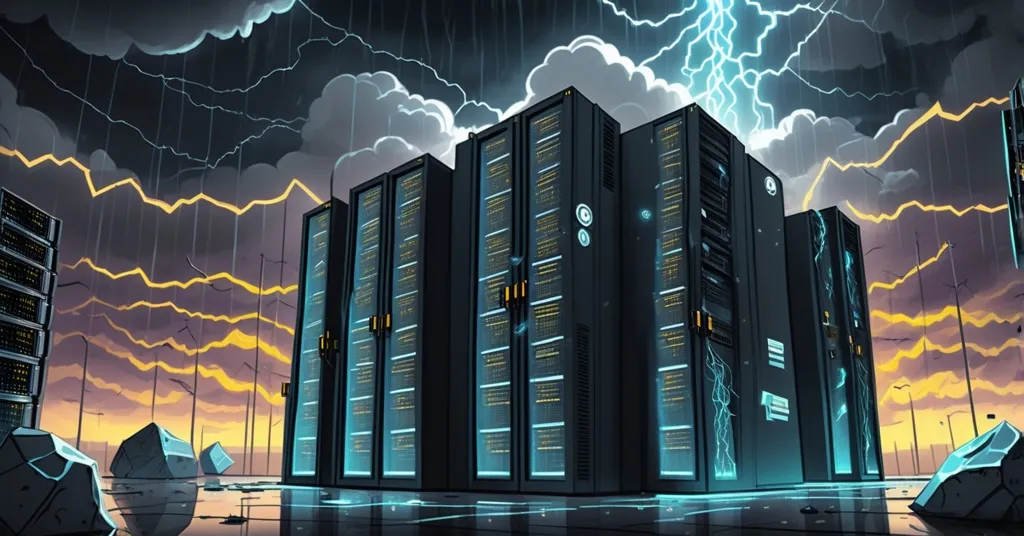Klarna Co-Founder Warns of AI Bubble: Echoes of Crypto Crashes Haunt Bitcoin’s Future

Klarna Co-Founder Slams AI Infrastructure Frenzy: A Red Flag for Bitcoin and Crypto?
Sebastian Siemiatkowski, co-founder of fintech heavyweight Klarna, has fired a warning shot across the bow of the AI industry, calling out the jaw-dropping investments in data centers and infrastructure as a potential bubble waiting to burst. With tech giants dumping billions and his own stakes in AI pioneers like OpenAI, his critique carries weight—and for those of us rooted in Bitcoin and crypto, it’s a haunting echo of speculative disasters we’ve seen before.
- Staggering AI Investments: Alphabet, Amazon, Meta, and Microsoft spent $112 billion in Q3 on AI infrastructure, with OpenAI committing $1.5 trillion for future resources.
- Siemiatkowski’s Doubts: Despite backing AI firms, he questions if trillion-dollar server bets are worth it, fearing unsustainable overinvestment.
- Crypto Echoes: The AI mania mirrors past crypto bubbles like the 2017 ICO craze, with systemic risks for everyday investors via index funds.
The Trillion-Dollar AI Gamble: Innovation or Insanity?
Let’s cut to the chase: the numbers are staggering. In just the third quarter, tech behemoths—Alphabet, Amazon, Meta, and Microsoft—poured a collective $112 billion into capital expenditures, largely for AI infrastructure like data centers and specialized hardware. That’s more than the GDP of many small nations. Meanwhile, OpenAI, a company currently operating at a loss, has locked in commitments worth $1.5 trillion for future computing resources. To put that in perspective, it’s enough to fund multiple moon missions or rebuild entire economies. Siemiatkowski, whose family office Flat Capital holds stakes in AI players like OpenAI, Perplexity, xAI, and Cerebras, isn’t cheering from the sidelines. Even as Klarna itself has embraced AI—automating two-thirds of its customer service interactions and cutting over half its workforce through tech-driven efficiencies—he’s sounding the alarm.
“I think [OpenAI] can be very successful as a company but at the same time I’m very nervous about the size of these investments in these data centers,”
he stated bluntly. His concern isn’t about AI’s potential but whether the scale of spending makes any damn sense.
“[But] that’s a different thing than asking myself ‘is it worth putting a $1tn worth into servers.’ I am concerned that piling that kind of money into data centers may turn out to be not worth it.”
For those new to the game, AI infrastructure is the physical and digital muscle behind artificial intelligence—massive data centers stuffed with servers and high-powered chips, often from companies like Nvidia, that train and run models like ChatGPT. Think of it as Bitcoin mining farms on a galactic scale, chugging energy and cash to process terabytes of data for a single AI model update. Nvidia, the golden child of AI hardware, boasts a valuation of $4.5 trillion—a number so absurd it could buy a fleet of Lambos for every Bitcoin hodler on the planet. Yet, cracks are showing. Recent sell-offs in U.S. AI stocks hint at investor nerves, and even Michael Burry, the hedge fund maverick who predicted the 2008 housing crash, shut down Scion Capital after shorting Nvidia and Palantir, citing market madness.
“I partially agree with Michael Burry. The question again is about timing because he’s betting against the whole market,”
Siemiatkowski noted, showing he’s not entirely dismissing the bearish outlook, though he’s cautious on predicting an imminent collapse.
Echoes of Crypto’s Dark Past: The ICO Ghost Returns
If you’ve been in the crypto trenches, this AI spending spree feels like a rerun of a bad movie. Cast your mind back to 2017, when Initial Coin Offerings (ICOs)—crowdfunding schemes for blockchain projects—raised over $5 billion on nothing but hype and half-baked whitepapers. Roughly 80% of those projects turned out to be scams or outright failures, leaving retail investors holding the bag. The AI infrastructure rush reeks of the same irrational exuberance, just with shinier tech and bigger zeros. And much like the ICO craze, the ripple effects hit far beyond the speculators. Siemiatkowski points to a chilling reality: through index funds—those “safe” diversified investments tied to the S&P 500 or tech-heavy portfolios—everyday people, including pension holders, are unknowingly exposed to this AI gamble. Your retirement savings could tank if Nvidia’s bubble pops, even if you never touched a single share.
“That makes me nervous, because of the amount of wealth that is currently automatically allocated into this trend, without some more thoughtful thinking,”
he warned, highlighting the systemic risks of passive investment in overhyped sectors as noted in a recent discussion on Klarna’s co-founder warning about AI infrastructure mania.
Let’s be real: we’ve seen this in crypto too. When Bitcoin crashed from its 2017 peak, or when shady altcoin pumps like Bitconnect imploded, it wasn’t just the degens who got burned—regular folks dabbling in “the next big thing” lost life savings. The AI frenzy could drag down broader market sentiment, and Bitcoin, despite its rock-solid fundamentals, might get unfairly painted with the same “tech hype” brush. If risk-averse investors flee after an AI crash, adoption of decentralized money could stall. Are we sleepwalking into another systemic screw-up, with grandma’s pension on the line?
Centralized Gambles vs. Decentralized Strength
As Bitcoin maximalists, we often tout BTC as the antidote to centralized financial messes, and Siemiatkowski’s critique only sharpens that contrast. Unlike AI giants reliant on corporate-controlled data fortresses, Bitcoin’s network thrives on thousands of independent node operators worldwide—a truly decentralized backbone no single entity can monopolize. Its fixed supply of 21 million coins and censorship-resistant design stand in stark opposition to the inflated valuations of tech stocks like Nvidia. Hell, even during the dot-com bust of the early 2000s, the seeds of blockchain were sown as a rebellion against centralized failures. Yet, we can’t get cocky. Our space has its own skeletons—overcooked NFT drops, scammy altcoin schemes, and ridiculous price predictions that belong in a circus, not a market analysis. Siemiatkowski’s skepticism is a gut check for us to stick to fundamentals and not get swept up in adjacent tech fevers.
That said, altcoins and other blockchains like Ethereum deserve a nod. While Bitcoin remains king for sound money, Ethereum’s smart contracts and DeFi ecosystems carve out niches AI can’t touch—think decentralized lending or tokenized assets. This diversity in the crypto world is a strength, offering resilience against the kind of singular tech bets AI represents. We’re not just a one-trick pony, and that’s a damn good thing.
A Glimmer of Sanity: Efficiency as the Way Forward?
Siemiatkowski doesn’t just play the doom prophet—he offers a potential lifeline. He argues future AI models will act as a sort of “compression technology,” shrinking in size and power demands much like zipping a massive file on your laptop. He points to DeepSeek, a Chinese AI outfit, whose low-cost, energy-efficient models are already outpacing some bloated U.S. systems. If he’s right, the trillion-dollar data center arms race might be a colossal waste of cash.
This hits close to home for crypto folks. Bitcoin mining’s energy debates are legendary—critics love to bash its carbon footprint, often ignoring the push toward renewable energy by major operations. But look at layer-2 solutions like the Lightning Network, which slashes transaction costs and energy use for Bitcoin payments, or Ethereum’s shift to proof-of-stake with the Merge, cutting its power draw by over 99%. Then there’s rollups like Arbitrum and Optimism, optimizing Ethereum’s base layer for speed and efficiency. If AI can pull off similar tricks, as Siemiatkowski bets, maybe the infrastructure mania is just a temporary fever dream. Still, he senses the hype machine won’t slow down easily.
“People have an incentive to say I’m wrong. And I feel, behind doors, people are more concerned about what I’m saying than they are in public,”
he revealed, suggesting even AI insiders might be sweating under the surface while keeping up the public cheerleading act.
Could AI and Blockchain Converge for Good?
Let’s think bigger for a second. While AI’s current trajectory screams caution, there’s untapped potential for synergy with blockchain. Could AI algorithms optimize Bitcoin mining efficiency, pinpointing the best renewable energy sources? Might it enhance privacy protocols for wallets or transactions, building on projects like Monero or Zcash? These aren’t pipe dreams, but they hinge on AI shifting from hype to hard utility. As champions of effective accelerationism, we should push for tech that disrupts the status quo meaningfully—not just pads corporate balance sheets. If an AI bubble bursts, regulatory overreach could spill into crypto, much like post-dot-com paranoia delayed early blockchain progress. Staying vigilant isn’t just smart; it’s survival.
Key Takeaways and Questions for Reflection
- What’s behind the AI infrastructure spending spree?
Tech giants dropped $112 billion in Q3 on data centers and hardware to power AI models, betting on transformative tech, though profitability remains a massive question mark. - Why does Siemiatkowski doubt these investments despite his AI stakes?
He’s skeptical of trillion-dollar commitments like OpenAI’s $1.5 trillion for servers, arguing future models may need far less power and questioning if the spending justifies the returns. - How does AI’s hype stack up against crypto’s past bubbles?
It mirrors the 2017 ICO frenzy, where over $5 billion was raised on promises alone, only to crash, leaving retail investors exposed—much like index funds now tie everyday wealth to AI giants. - What risks do average investors face from the AI boom?
Through index funds, personal and pension savings are funneled into AI stocks like Nvidia, valued at $4.5 trillion, risking huge losses if the market corrects, akin to crypto bear market pain. - Can AI efficiency mirror blockchain scaling solutions?
Siemiatkowski bets AI will get leaner, citing DeepSeek’s low-cost models, similar to how Bitcoin’s Lightning Network or Ethereum’s rollups cut costs and energy compared to base layers. - What can Bitcoin and crypto learn from this AI warning?
Stick to fundamentals—decentralization, fixed supply, and real utility—while avoiding speculative traps. Bitcoin’s resilience offers a counter to centralized tech gambles, but we must stay sharp against our own excesses.
As we rally behind Bitcoin’s mission to upend financial gatekeepers, let’s not ignore the cautionary tales playing out in parallel tech arenas. AI’s runaway spending might be the warning bell we didn’t ask for but desperately need. Whether you’re a BTC diehard or an altcoin explorer, the lesson is clear: hype is a hell of a drug, and sobriety in fundamentals is our best defense. Let’s build a future of freedom and disruption, not repeat the same old crashes with fancier toys.



